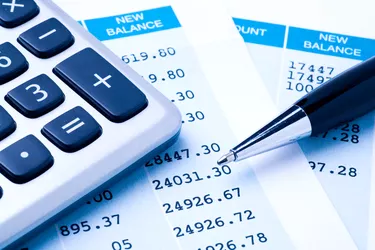
Financial terminology, and stock trading in particular, can be confusing and interconnected with many concepts, making them more intimidating and unapproachable. Fortunately, some of the core concepts can be relatively easy to calculate and understand. Buying and selling stock relies on knowing the market price per share of common stock to avoid taking a loss on an investment. The basic concept of stock trading is to buy low and sell high, but calculating and estimating growth or depreciation of a stock's value is generally tricky, relying on a solid understanding of the company's assets, liabilities and profit margins.
Understanding the Valuation Metrics for Stocks
Video of the Day
Stock prices should be evaluated by the last quote listed if trading during the day, or by the listed close price if trading after hours. According to the writers for the SEC, a balance sheet shows a business's assets opposite liabilities and shareholder equity at any given time. Consider the balance sheet a snapshot of the business's financial situation and overall value to investors. If shareholder equity is distributed regularly instead of retained and reinvested, that's called dividends.
Video of the Day
Shareholder's equity, for the record, is the balance remaining if a business sold off all assets and paid off all liabilities. Per Accounting Tools, the remaining amount would be the shareholders' equity, divided across the number of outstanding shares (the shares currently owned by investors and employees, not currently bought back by the business). Thus, if you need to determine the price per share of stock, you can look at a balance sheet and calculate it yourself.
The "book value" of a share, according to the writers from the Corporate Finance Institute, is based on a wholesale evaluation of liabilities subtracted from assets. When that book value is divided among the available shares, it's known as the book value per share. This approach is used mostly for capital-intensive businesses such as mechanical manufacturers and steel distribution services, and such stocks often trade as a percent of their "book" value.
Maximizing Profit From Stocks
As referenced above, the concept of buying low and selling high is central to all mercantile ventures, but how does the average trader know which stocks will appreciate to produce a profit instead of depreciating to drain their finances?
A significant consideration in buying stock in a company is forecasting their gains, and therefore your profits, but can you attempt that, given the uncertain nature of the future?
While the future is uncertain, you can make your best prediction based on the past and current performance of the business you're considering investing in. Check the balance sheet, determining the price per share of common stock and then watching how it ebbs and flows over time can inform your decision to buy or sell.
Consider also: How to Calculate Percentage Changes in Stocks
Financial Ratios and Multiples
The "multiple of the stock" is the expected future earnings of a business's stock (the current stock price divided by the difference between current and future earnings). The best financial ratios for investors are based on the current business earnings multiplied by the "historical multiple," which is the difference between current profits and expected profits in the next year, all multiplied by 100.
Once you've calculated the trajectory of a business from its past and current stock earnings, you can estimate future stock prices if all else holds steady. It's that last part that inevitably throws a wrench in the works, as other businesses will take action and supply chains will be interrupted by natural disasters and political upheaval. If you can find a business unaffected by these considerations, your calculations will be more reliable, but ultimately even the most stable stock trading carries a risk of loss.